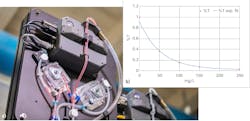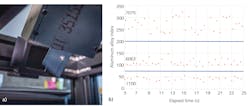Spectral sensors in industry increasing quality and efficiency
Sensors have long been an important aspect of manufacturing processes. As extensions of our human senses, they allow manufacturing personnel to monitor and control workflows, leading to savings in cost, energy, and materials—all while facilitating better-quality outcomes. Early process sensors were simple level gauges, sight glasses, thermocouples, and pressure sensors. These allowed viewing into closed vessels, as well as measurement of the pressure, volume, and temperature of chemical and biological reactions. Key parameters of color were still measured by comparison to standard color sheets, and any direct chemical or biological measurements were made by taking samples back to the laboratory.
Things began to change in the 1990s with the emergence of smaller and more portable light sources, lasers, and spectrometers. Ocean Insight (Orlando, FL), for example, developed the miniature crossed Czerny-Turner spectrometer almost 30 years ago—technology that touts portability as well as at-line and in-line measurement. Such technology has applications in biotechnology, energy, environment, pharmaceuticals, and the chemical industry, among others.
Challenges of sampling outside the lab
The original home of spectrometers was in the laboratory. However, as discoveries mounted and implementation methods progressed, it was only natural that spectral sensors would move into more demanding and rugged environments, namely the production floor and the real world. With this development comes the need for 24/7 reliability, high-throughput measurements, multiple modes of connectivity, and immunity from environmental changes in temperature, humidity, dust, water, and sometimes even radiation.
To highlight just one of these challenges, communication in industrial environments can take place via systems including Modbus, Profibus, Ethernet, and EtherCAT. Data formats and presentation vary, and there is increasing need for cloud-based machine learning and data storage support. Add to that the fact that each individual sensor is expected to deliver identical results to other sensors of the same type, and it’s clear to see the complexity involved in delivering spectral solutions in the field.
Industrial application development process
It is important to understand the specific needs in a particular application environment while developing a solution. Systems such as those from Ocean Insight and others initially built by FluxData (Rochester, NY), which tout a one-size-fits-many (as opposed to one-size-fits-all) approach, combine high-performance spectroscopy with advances in mechanical design to deliver specific solutions applicable to a range of industrial problems.
One such system is a spectral sensor system developed by Ocean Insight—the SpectraNova D8 (see Fig. 1)—which uses spectrometers for rapid color control of parts in consumer electronics manufacturing lines.
While previous color inspection systems relied on contact with the part to obtain precise surface color measurements, this instrument has a compact, noncontact inspection system that fits easily onto production line machinery and performs color measurement of each part in 150 ms or less. This allows more than 500,000 sample measurements per day, enabling rapid automated workflows on modern production floors. It also maintains a CIE76 color-difference repeatability of 0.01 ∆E*ab (standard deviation). For industries such as consumer electronics, where high-volume demand meets high customer expectations, the ability to perform high-throughput quality control while maintaining precision and accuracy is crucial.
Liquid color and transmission measurements
Another example is the development of a Liquid Transmission Measurement System (LTMS; see Fig. 2), which analyzes color proactively from aluminum anodization baths. While originally designed for color measurement, technology such as this can also measure liquid concentration via absorption or transmission. Importantly, a portable spectrophotometer system can be tightly integrated into the production workflow, eliminating the need to transport samples to a lab or workbench.Technology, such as that included in the LTMS, allows simple fluid handling that extracts a sample directly from the batch tanks and diverts it to the spectral sensor system for analysis. The light source-compensated transmission/absorption data is then communicated over the protocol of choice. The entire process, from sample extraction to data presentation, occurs in seconds. These systems must operate accurately over a wide range of possible temperatures in the factory. High availability is an absolute requirement, as product manufacturing is often a 24/7 operation.
Material composition measurements
Laser-induced breakdown spectroscopy (LIBS; a laser-generated plasma that allows elemental emission measurements from a distance) and Raman spectroscopy also utilize spectroscopic measurement technology. Systems now in development—among them a system by Ocean Insight—are targeting molecular and biological measurements using Raman and near-infrared spectroscopy, and elemental and bulk composition measurements using LIBS.
For example, Ocean Insight’s SpeedSorter, a modular system primarily designed for light-metal scrap sorting applications (see Fig. 3), uses LIBS. Alloys containing elements such as aluminum, magnesium, and silicon cannot be easily separated using conventional means. Light metals are particularly responsive to LIBS, allowing systems to distinguish these alloys with a high level of accuracy.Other base metals can also be sorted, such as magnesium alloys or titanium. As scrap sorting facilities often operate at near-ambient temperatures in regions around the globe, and pieces of scrap can be covered with paint, oil, and grime, these systems must be tolerant of a wide range of operating conditions.
Another emerging application for LIBS is field identification of minerals and composition of geological samples. Formerly, this analysis relied on laboratory-based techniques such as inductively coupled plasma (ICP), laser ablation, and x-ray fluorescence (XRF). LIBS has brought this analysis out of the lab and into the field, offering in-line, expedited lab-grade analysis. For high-throughput, standoff measurements, including those required in mining as well as oil and gas applications, LIBS is nearly a perfect fit.
Spectral sensors delivering quality and efficiency
In each case, spectral sensors are bringing improved quality and efficiency to the factory floor, industrial applications, or resource exploration. The precision, accuracy, speed, and flexibility of these sensors make them well suited for industrial applications, enabling high-throughput, lab-grade quality control to integrate with current process workflows. Designing sensors to work in rugged industrial environments has its challenges, but the payback can be immense. Within the next decade, significant increases in connected sensor deployment are expected, namely in industrial applications.
Steve Buckley | General Manager of Applied Systems, Ocean Insight
Steve Buckley is General Manager of Applied Systems at Ocean Insight (Orlando, FL).
Lena Gandevia | Strategic Market Specialist of Applied Systems, Ocean Insight
Lena Gandevia is Strategic Market Specialist of Applied Systems at Ocean Insight (Orlando, FL).


